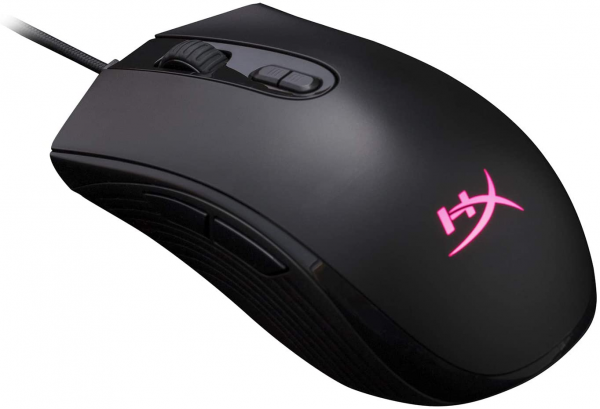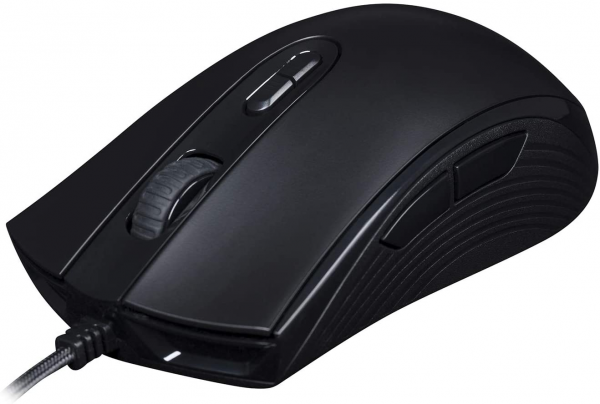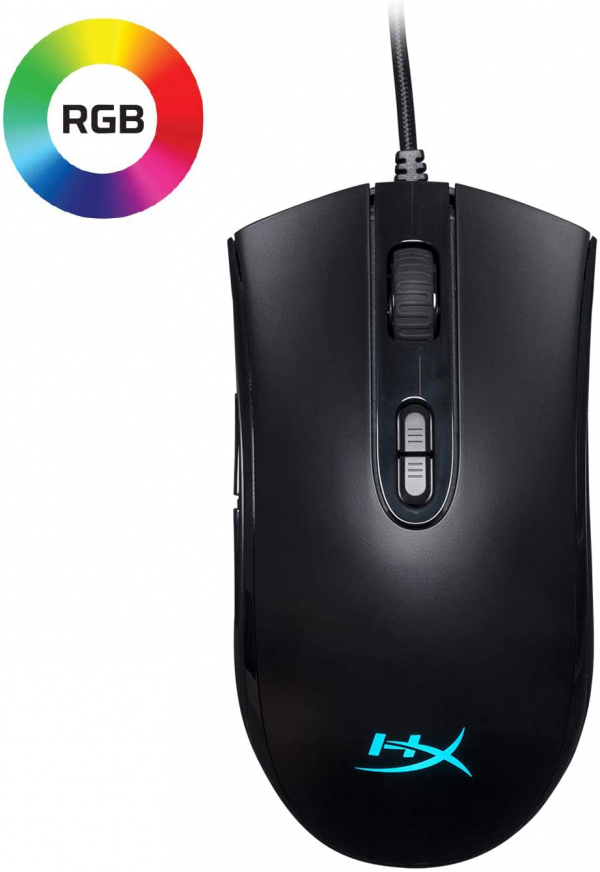HyperX
HyperX Pulsefire Core: a light, symmetrical and inexpensive gaming mouse
Aprox. 27€ - see price -
See specificationsComing to strengthen the HyperX mouse range of a fourth model, the Pulsefire Core is a simple and efficient mouse. It could convince more than one thanks to its sale price below 40 €. Provided of course to ensure the essential ...
Positive points
Light and handy mouse.
Good sliding.
Accurate and responsive.
Agreed but effective design.
Bad points
Still lacks grip.
Software stingy with possibilities.
Acceleration / smoothing impossible to deactivate.
Symmetrical, but not ambidextrous.
Our review
Ergonomics
Like the Pulsefire Surge from the same manufacturer, this Pulsefire Core cannot claim the status of a truly ambidextrous mouse. Indeed, if its design is perfectly symmetrical, it has two slice buttons on the left that we do not find on the right. Result, it is to be stored in the box - full - of mice that we recommend especially to those who play the "mouse" with the right hand.
Otherwise, it is a rather small mouse (11.9 cm long, 6.4 cm wide) and rather light (87 grams), whose palm rest is fairly rounded (4.1 cm at highest point). Mounted on two large PTFE pads, its glide proves to be impeccable, whether on the hard surface of a desk or on a fabric carpet.
It has a total of 7 programmable buttons, counting in addition to the 2 main clicks and the 2 slice buttons the click wheel as well as the 2 small upper buttons used as resolution selectors. The behavior of all these buttons is true to what you would expect from such a mouse. The wheel (rubberized, notched and silent) benefits from a pleasant and frank click. Edge buttons provide dry, responsive feedback. While the two main clicks benefit from a good rebound (it is possible to chain the clicks without frenzy frantically).
Their switches, guaranteed for 20 million clicks, have a rather muffled sound (which is not to displease us). On the other hand, the small upper buttons are too soft in our opinion and are difficult to distinguish in the heat of the action, although they remain sufficiently accessible to be usable.
In hand, the mouse is particularly handy. Because of its lightness and good glide, it is one of those that can be moved from left to right without the slightest annoyance or fatigue, and without having the impression of losing precision in it (we will come back). If we appreciate the use of a small diameter braided cable which also favors movement, we must admit that we still regret the use of a different material on the slices of the mouse, which could have brought better grip. Not to mention soap, very slightly textured hard plastic is insufficient for our taste to guarantee an ideal grip.
The last touch of style is - of course - brought by an RGB led hidden behind the HyperX logo engraved in the shell of the mouse. A configurable visual effect on 16.8 million colors - even deactivable.

Precision
In terms of precision, the performance of the Pulsefire Core from HyperX is entrusted to a Pixart PMW3327 optical sensor whose native sensitivity can climb up to 6,200 dpi (which is more than enough, even equipped with an Ultra HD screen). A sensor capable of absorbing maximum accelerations of 30 g and ensuring flawless tracking up to a speed greater than 5.5 meters per second.
Not being equipped to technically verify these data provided by the sensor manufacturer, we can nevertheless affirm that on a daily basis, for a mixed office / game use alternating fast FPS and precise clipping work with Photoshop, we never had to complain about the behavior of this mouse.
The only thing to note, the mouse applies a certain amount of acceleration to the movements made, and the movement of the cursor on the screen is therefore not exactly representative of the area covered by the movements of the wrist. A peculiarity that we integrate quickly enough and which is not sufficiently pronounced to have hindered us in our practice of video games. However, it is possible that seasoned players complain about such behavior and seek to deactivate this acceleration ... which is unfortunately not possible.
As always with optical sensors, glossy coatings or glass are not surfaces that guarantee optimal functioning of the sensor. Finally, we note that the mouse communicates movements and clicks every millisecond with the system (thanks to a polling rate of 1000 Hz).

Conclusion
A cheap alternative to the Pulsefire Surge, this Pulsefire Core with limited ambitions on paper is doing relatively well in practice. Very handy because of its lightness and its excellent glide, not tiring to use long hours, it nevertheless sins on some details: a lack of grip, an acceleration of the sensor movements impossible to deactivate, a symmetrical design but a design not -ambidextrous and software that deserves a little more care and richness. Sold for around forty euros, it will find it hard to find a place in a popular segment where the Logitech G403 Prodigy or Corsair Optical Saber reign supreme, alongside of course the essential G502 Proteus Spectrum from Logitech.

Specifications
Reviews


Mouse is great. Not sure why other review is upset
Mouse is great. Not sure why other review is upset, you bought a mouse shaped for a palm grip and expected something else? Fps is immaculate. Helped my aim on overwatch a lot. The dpi settings grip and smooothness.
Awesome!
Good mouse, inexcusably horrible software
First, the good ..
The mouse is nice. It has a good feel, a nice weight and it's very responsive both in Wired and Wireless mode. The LED's are nice, they aren't obnoxious and they have a perfect level of brightness that accents the mouse without being ugly. It seems to be well constructed, it feels solid under your hand and it's a very comfortable mouse.
Now the bad ..
Yet another company that just can't handle the simple concept of Mouse Software. This one however, is the worst I have seen yet. The NGenuity Software is not a stand alone installer, it's a Windows Store App. It doesn't run in your tray, it has to stay open in your task bar or you can't have any custom settings for the mouse. If you don't want to have an application open in your tray all the time, you have no customization .. at all. This is inexcusable.
If you turn the mouse off, the horrible software loses all settings. When you turn it back on, you then have to go into the software and select the profile again .. every time. If you plug the mouse in to charge .. now it sees as it as a different mouse and you need a whole new set of profiles. It baffles the mind how horrible this software is.
The mouse is good, but I'll likely return it because this software is just unacceptable. Maybe it will be refined later (It's currently listed as beta version) but right now it's borderline unusable. Avoid this until they release some actual working software unless you're happy with just using the default settings (800/2000/3200 with RGB Breathing effect.)
Could certainly do worse, especially on sale.
Bought this mouse because I wanted to try a larger one than the ones I had (a Nixeus Revel and a Corsair Harpoon RGB), and it was at a pretty good discount at the time of purchase ($ 35, normally retails for ~ $ 50). I've used it for about two weeks, so I feel like I can give a fair assessment about what I like / dislike so far.
LIKES:
* Solid construction, actually feels like it can take a beating
* Plug and play, no fancy drivers needed
* Not too flashy, doesn't have unnecessary RGB all over it
* Mostly well-designed (more on that in a second)
* Braided cable doesn't snag like some of my other mice
DISLIKES:
* Sides are at an odd angle (they're angled in towards the top, whereas most mice angle in towards the bottom)
* Rubberized grips don't grip, especially if your hands get sweaty at all
* Scroll wheel developed an annoying squeak less than a week after I got it
Overall, while I do have some gripes about the shape of the mouse, it's still not a terrible choice, especially if you have larger hands like I do. It's still fairly comfortable in a palm grip, but you may have to hold on somewhat tightly so that it doesn't slide out of your hand. I think it's still decent bang for your buck, especially if you can snag it on sale like I did, and don't mind the palm-grip-only sculpting.
Updated 12/5/19. Feels good, looks good and handles well so far.
Disclaimer: I've only had ~ 2 days with this mouse so far. I mostly play WoW but play other games on the side such as BO4 / CS.
Edit: 12/5/19. Everything I said below has remained completely true for the entire year + that I've had this mouse. It feels really good, it's very durable and it looks really nice. No tracking issues, no left / right click issues that plague other mice, no durability issues, etc. It's worked extremely well for me since I bought it. Very happy overall.
Review:
1. Feel: This mouse feels extremely nice. The grips on the side are made of a very grippable and seemingly durable material. I was able to lift up the mouse so easily I didn't even notice when I was doing it most of the time as it should be. The ergonomics are great as well, fit perfectly in my hand. Hand size is 6.70 inches. The sensor works perfectly as expected from one of the best on the market. It's really smooth. The mouse is fairly light in my opinion and glides across the mouse pad nicely.
2. Look: The mouse looks and feels like a professional mouse (if that's what you wanna call it). The LEDs are very bright and have 3 different patterns (Cycles through colors aka breathing, 1 color mode or no lights). Mouse wheel and logo are very well lit.
3. Durability: As I've said I've only had it for 2 days so I can only comment on what I've felt / seen so far. All of the material looks and feels very durable. I'm hoping this stays true.
4. Software: It's simple and easy to use. That's all there really is to say. If you wanna get more in depth you can watch some guides but overall it's easy to navigate and not riddled with bugs (so far) like Synapse.
TLDR: Feels good, looks good and handles well. Feels well built and durable. Only had it for 2 days and will update the review later down the line but so far so good. Can't find anything negative to say about it so far but I'm also not a super picky person.